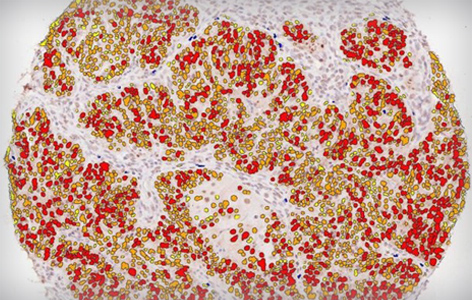
By: Laura Kuhlmann, Postdoctoral Fellow at Princess Margaret Cancer Centre
Since their invention in the 17th century, optical microscopes have revolutionized biology. Light microscopes use a system of lenses that magnify features of interest, which are further highlighted with contrast methods. Advances in physics and technology now make it possible to not only visualize cells, subcellular organelles or protein distribution, but also track their movement and their interactions.
Several state-of-the-art microscopes are available at the Advanced Optical Microscopy Facility (AOMF) at UHN. AOMF serves approximately 600 users yearly from UHN and external institutions. The facility offers access to over 40 microscopes distributed across four sites: Princess Margaret Cancer Research Tower, Toronto General Hospital, Princess Margaret Hospital and the Krembil Research Institute at Toronto Western Hospital. Users can access and receive help with a multitude of optical microscopy applications including confocal, super-resolution, live-cell and in vivo imaging, whole-slide scanning, as well as quantitative analysis of acquired data.
However, simply using state-of-the-art instruments does not automatically translate into quality results. James Jonkman, manager of the AOMF, shared his thoughts on how UHN researchers can optimize their data acquisition and quantification.
The best way to get started is to first consult with the core facility staff about your project. Teaching materials are available on the AOMF website under the resources tab or on vendors’ website, but “it can be a little bit overwhelming, and it is not packaged together into a nice story,” says Jonkman. The AOMF staff offer free consultations to aid researchers optimally plan their experiment and make use of the best-suited microscope(s) available. The AOMF also organizes comprehensive courses several time a year, which include 30 hours of hands-on microscope instruction. The next available course is scheduled for June 15 to 19, 2020.
Handling the microscope isn’t necessarily the most daunting task. Sample preparation is one of the biggest problems new users must deal with. “People underappreciate how much you need to optimize each step.” warns Jonkman. Multiple parameters aren’t easily transferable from one experiment to the next. The AOMF offers guidance with sample preparation but doesn’t offer it as a service. Jonkman also advises users to first check their slides on an available microscope (e.g., in their lab), to confirm that the experiment worked before booking one of the facility’s instruments.
Another common problem is that users do not follow up with the AOMF staff once they get started. The AOMF can help users decide on their quantification strategy and recognize if the imaging parameters need to be improved. “We want people to get the best results possible,” adds Jonkman. Acquiring all the data first and checking if they are suitable for quantification afterwards can significantly set back an experiment.
For tips on how to improve your confocal microscopy experiments, tune in next month when AOMF manager James Jonkman discusses his upcoming Nature Protocols paper that offers step-by-step guidance for quantitative confocal microscopy.




